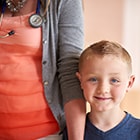Getting Kids Home Sooner After Surgery for Adolescent Idiopathic Scoliosis

“Since we put standardized procedures in place, we reduced length of stay from four days to 2.7 days,” says Peter Sturm, MD, MBA, director of the Crawford Spine Center. Sturm led a multidisciplinary team in establishing a protocol that emphasizes rigorous post-operative care by a variety of services. Their work reduced the complications of the spinal surgery and virtually eliminated surgical site infections.
Sturm emphasizes the importance of the multidisciplinary effort. “This is not just orthopaedics,” he says. “It requires hospitalists, pulmonary specialists and physical therapy all working together.”
He notes that although kids with AIS are otherwise healthy, correcting curvature of the spine is major surgery that not long ago required hospital stays of a week to 10 days. Now, he says, “physical therapy has these kids walking up and down stairs shortly after surgery, and they are walking when they go home. Allowing them to get back home quickly does wonders for their recovery.”
Sturm and his team are now developing a protocol for children with neuromuscular disorders who require spine surgeries. Although these children have much more complex medical needs, he says, he is confident that standardizing their post-surgical care and evaluation will result in improved outcomes and quicker returns to their home environment.
“What we’re trying to do is to cut subjectivity, have objective criteria the kids need to meet before we will discharge them. Our goal is to move them back into their home environments as soon as possible.”

